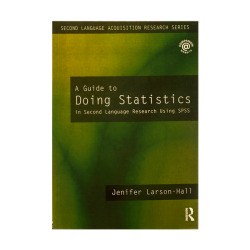The role of the first language for Exam
Chapter 2
The role of the first language for Exam
Summarized: Saeed Mojarradi Ph.D Candidate
It is a popular belief that second language acquisition (SLA) is strongly influenced by the learner’s first language (L1). The clearest support for this belief comes from ‘foreign’ accents in the second language (L2) speech of learners. When a Frenchman speaks English, his English sounds French. The learner’s L1 also affects the other language levels —vocabulary and grammar. This is perhaps less immediately evident. It is also a popular belief that the role of the L1 in SLA is a negative one. Corder (1978a) has referred to this view of SLA as a ‘restructuring process’.
Talking about the behaviorist learning theory, we know that in order to understand the early importance that was attached to the role of the first language, it is necessary to understand the main tenets of behaviorist learning theory.Then,Two key notions can be identified in these discussions: ‘habits’ and `errors’.
Behaviorist psychology set out to explain behavior by observing the responses that took place when particular stimuli were present. Different stimuli produced different responses from a learner. These responses could be haphazard (in the sense that they could not be predicted), or they could be regular. The association of a particular response with a particular stimulus constituted a habit.
Behaviorist psychologists attributed two important characteristics to habits: The first was that they were observable.
A habit was formed when a particular stimulus became regularly linked with a particular response. There were various theories about how this association could take place.If the stimulus occurred sufficiently frequently, the response became practiced and therefore automatic. In the neo-behaviorism of Skinner a rather different account of how habits developed can be found. Skinner played down the importance of the stimulus, on the grounds that it was not always possible to state what stimulus was responsible for a particular response. Instead he emphasized the consequences of the response. The learning of a habit, then, could occur through imitation.
Theories of habit formation were theories of learning in general. They could be and were applied to language learning. In L1 acquisition children were said to master their mother tongue by imitating utterances produced by adults and having their efforts at using language either rewarded or corrected.
According to behaviorist learning theory, old habits get in the way of learning new habits. Where SLA is concerned, therefore, ‘the grammatical apparatus programmed into the mind as the first language interferes with the smooth acquisition of the second’
The learner does not need to overcome proactive inhibition by mastering a different realization device. Behaviorist learning theory predicts that transfer will take place from the first to the second language. Transfer will be negative when there is proactive inhibition. In this case errors will result. Transfer will this case no errors will occur be positive when the first and second language habits arc the same. By comparing the learner’s native language with the target language, differences could be identified and used to predict areas of potential, error. In this way classroom practice could be directed on the problem areas in order to help the learner overcome the negative effects of first language transfer. Having examined the main principles of behaviorist learning theory as it was applied to SLA, it is time to consider the means that were used to predict potential errors. These were contained in the procedure known as Contrastive Analysis.
Contrastive Analysis : As Lado (1957), one of the prime movers of Contrastive Analysis, makes clear, `The teacher who has made a comparison of the foreign language with the native language of the students will know better what the real problems are and can provide for teaching them’. The origins of Contrastive Analysis, therefore, were pedagogic. This was reflected in comparisons of several pairs of languages by scholars in the United States, all directed at establishing the areas of learning difficulty that were likely to be experienced by English speakers learning other languages. In order to hypothesize that the errors in a corpus are interference errors, a contrastive analysis must have taken place. It makes little sense to conduct a complicated contrastive analysis simply to confirm what a de facto analysis suggested. If Contrastive Analysis is to be worthwhile, it should be predictive.
Diagnosis will then’ remain the job of Error Analysis. Ideally the psychological aspect of Contrastive Analysis should deal with the conditions under which interference takes place. That is, it should account for instances when linguistic differences between the first and second languages lead to transfer errors and instances when they do not. It is because it is not possible to predict or explain the presence or absence of transfer errors solely in terms of linguistic differences between the first and second languages that a psychological explanation is necessary.
The linguistic aspect of Contrastive Analysis: A comparison of two languages can be carried out using any of several different models of grammar. Initially the model used was that of structuralism linguists. This emphasized the importance of detailed ‘scientific description’ of languages based on a description of the different categories that make up the patterns of a language. These categories were defined in formal terms and they were established inductively.
Here are some of the possibilities that a comparison might reveal:
1- No difference between a feature of the first and second language e.g. the contracted form Tar in French is mirrored by the contracted form ‘I’ve’ in English. 2- ‘Convergent phenomena’ (i.e. two items in the first language become coalesced into one in the L2) e.g. Where the L2 is English, German ‘kennen’ and ‘wissen’ coalesce into ‘know’. 3- An item in the first language is absent in the target language e.g. In German, subordinate clauses require a different word order from main douses, whereas in English the word order is the same in both clause types.4- An item in the first language has a different distribution from the equivalent item in the target language e.g. In many African languages [D] occurs word-initially, but in English it only occurs word medially or finally (e.g. singer or thing).5- No similarity between first language feature and target language feature e.g.
Criticisms of the Contrastive Analysis hypothesis: The criticisms that gathered force in the early 1970s were of three major types. First, there were the doubts concerning the ability of Contrastive Analysis to predict errors. These doubts arose when researchers began to examine language-learner language in depth. Second, there were a number of theoretical criticisms regarding the feasibility of comparing languages and the methodology of Contrastive Analysis. Third, there were reservations about whether Contrastive Analysis had relevant to offer to language teaching. Contrastive Analysis was the result, therefore, of empirical, theoretical, and practical considerations.
Theoretical criticisms: A number of rather different issues will be considered under this heading. These are: (1) The attack on behaviorist accounts of language learning which was given impetus by Chomsky’s (1959) review of Skinner’s Verbal Behavior; (2) The nature of the relationship between the notion of ‘difficulty’, as predicted by a contrastive analysis, and `error’.
Chomsky’s attack on behaviorism struck at the psychological basis of theories of language learning. It was argued by Chomsky and others that extrapolating from studies of animal behavior in laboratory conditions, as Skinner did, could show nothing about how human beings learn language in natural conditions.
The terms ‘stimulus’ and `response’ were dismissed as vacuous when applied to language learning, because it was not possible to tell what constituted the stimulus for a given speaker response. The concept of ‘analogy’, which Skinner had evoked to account for the language user’s ability to generate novel sentences, was ridiculed as far too crude a notion to capture the creative use of language that lay within each individual’s competence.
Practical criticisms: There are other doubts as well. Many of the predictions made by Contrastive Analyses proved to be superficial, in the sense that they did no more than confirm the average teacher’s practical experience of where errors were likely to occur. Also, if, as was later claimed by Sanders (1981), it was necessary to present learners with items which were similar to their first language and which were not, therefore, predicted to cause difficulty, as well as with items that were different from their Li, the whole rationale of Contrastive Analysis appears less certain.
Reappraisal: Although the ‘crisis’ in Contrastive Analysis has not been entirely resolved, in recent years there has been a successful reappraisal of the role of the L1 in SLA. This reappraisal took two forms. Language transfer re-examined: There were three noteworthy developments of the Contrastive Analysis hypothesis. First, it was recognized that the difficulty predicted by Contrastive Analysis might be realized as avoidance instead of error. Second, empirical evidence was forthcoming to show that interference was more likely to take place when there was some similarity between the first and second language items than when there was total difference. Third, and perhaps most important, it was recognized that error was a multi-factor phenomenon and that interference, as one of the factors, interacted in complex ways with other factors.
Avoidance: The evidence for avoidance induced by the first Language was first provided in a now famous study by Schechter (1974). Schechter investigated the relative clauses produced by adult L2 learners from different language backgrounds. She found that Chinese and Japanese learners, whose first languages do not contain English-like relative clauses, made few errors, while Persian and Arabic learners, whose first languages resemble English in relative clause structure, made far more. On the face of it, this contradicts the Contrastive Analysis hypothesis, but Schechter also observed that the Chinese and Japanese students made.
Degree of similarity: The Contrastive Analysis Hypothesis was founded on transfer theory, which stated that learning difficulty was the result of interference from old habits in the learning of new habits. It should follow, therefore, that difficulty (and therefore errors) will correlate positively with the magnitude of the distance between languages. The greater the difference, the greater the difficulty and the more numerous errors will be. This did not always prove to be the case, however.
L1 interference as a learner strategy: The Contrastive Analysis hypothesis fell into disfavor because it was apparent that large numbers of errors could not be predicted or explained by it. It is not surprising that researchers turned to other explanations of SLA. In particular the behaviorist view of language learning as habit-formation was rejected in favor of a more mentalist approach which took into account the active contribution of the learner. Viewing SLA as a process in which the learner is actively engaged involves attributing to the learner strategies for both sorting the L2 data into a form in which it can be stored and for making use of knowledge already in store.
Summary and Conclusion: Although in popular belief SLA is strongly influenced by the learner’s L1 there is considerable disagreement among researchers about the extent and nature of role of the L I. The explanation for this lies mainly in the changes that have taken place in the psychological base for examining SLA. The role of L.1 was first seen in terms of transfer theory and was closely linked to behaviorism, which saw SLA as a process of habit-formation. Errors, according to this theory, were the result of interference from the entrenched habits of the Li. Contrastive Analysis was developed in order to predict the areas of difficulty that learners with specific L1s would experience, so that teaching could provide massive practice to eliminate the chance of errors induced by the first language.



